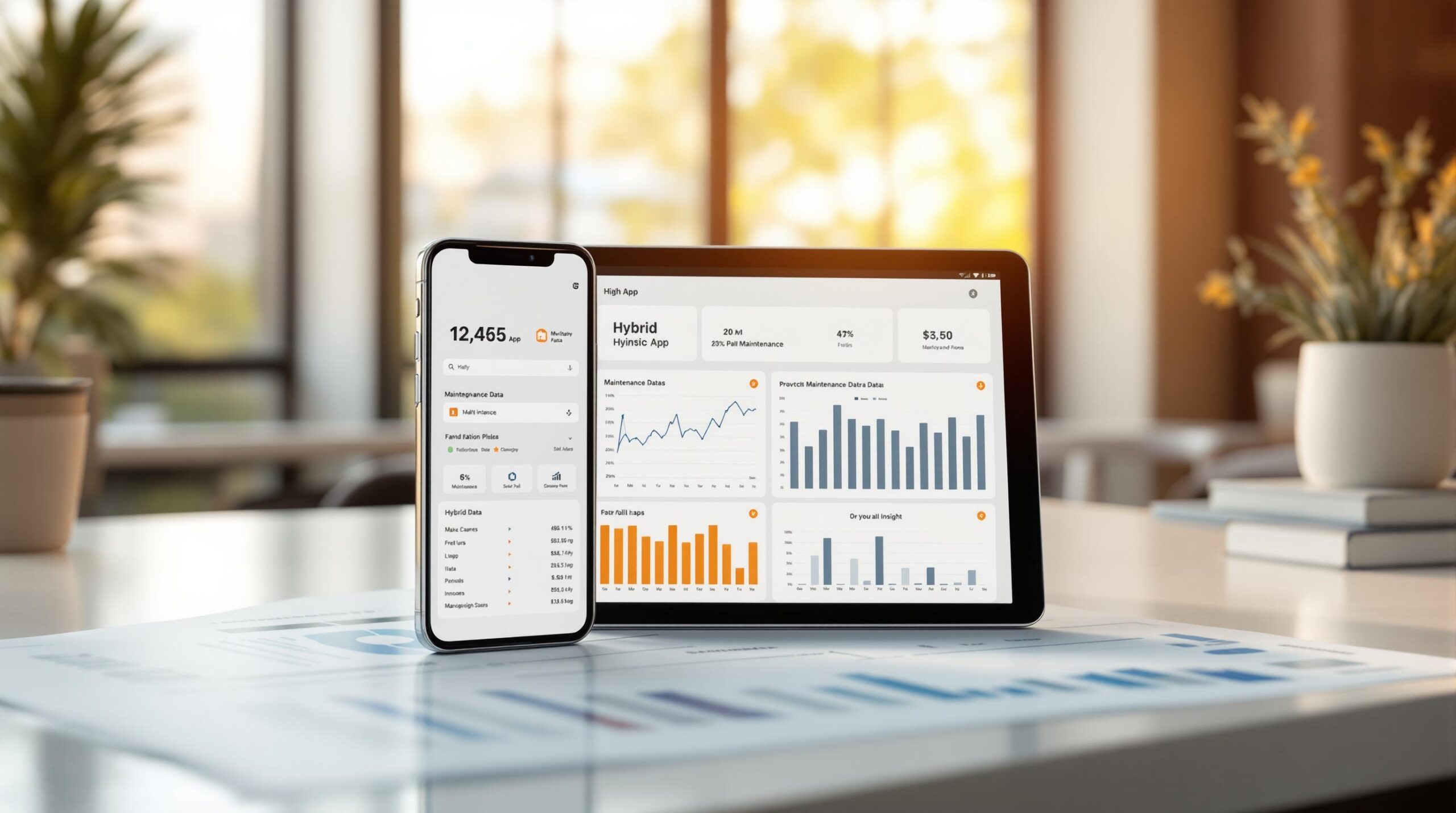
When it comes to maintenance data visualization, choosing between native apps and hybrid apps depends on your priorities. Here’s a quick breakdown:
Key Differences:
- Native Apps: Built for specific platforms (iOS/Android), offering top performance, advanced features, and platform-specific user experience. Ideal for real-time data processing and complex visualizations.
- Hybrid Apps: Built with one codebase for all platforms, providing faster development and lower costs. Best for simpler tasks and broader device compatibility.
Quick Comparison:
| Aspect | Native Apps | Hybrid Apps |
|---|---|---|
| Performance | Faster, optimized for heavy tasks | Slower, limited for complex tasks |
| Development | Separate codebases, higher cost | Single codebase, lower cost |
| User Experience | Tailored to each platform | Consistent across platforms |
| Device Access | Full hardware integration | Limited hardware access |
| Scalability | Handles large datasets well | May struggle with growth |
Summary:
- Choose native apps for industries like healthcare and manufacturing where speed, precision, and advanced features are critical.
- Opt for hybrid apps if your focus is cost-saving, quick deployment, and basic functionality.
The decision ultimately depends on your performance needs, budget, and long-term goals.
Mobile Apps – Web vs. Native vs. Hybrid
Comparing Native and Hybrid Apps
When deciding between native and hybrid apps for maintenance data insights, factors like performance, development costs, and long-term maintenance are key considerations.
Performance and Speed
Native apps are better suited for tasks that demand heavy resources, such as 3D graphics, real-time sensor data processing, and advanced analytics. They achieve this by directly accessing hardware, which results in faster speeds and smoother performance. This makes them ideal for handling large datasets and complex operations.
| Performance Aspect | Native Apps | Hybrid Apps |
|---|---|---|
| Data Processing Speed | Direct hardware access for faster speed | Additional processing layer slows down |
| Graphics Performance | Full access to native GPU capabilities | Limited by web view capabilities |
Development Time and Costs
The choice between native and hybrid apps often comes down to trade-offs in development. Native apps require separate codebases and specialized knowledge for each platform, which can increase both costs and timelines. On the other hand, hybrid apps use a single codebase, allowing for quicker development and lower initial costs. However, this can come at the expense of performance.
Balancing these trade-offs is essential for effective project planning and meeting both budget and timeline goals.
Maintenance and Growth
For apps focused on maintenance data visualization, scalability and seamless feature updates are essential to manage growing datasets and evolving user expectations. Native apps are better equipped to handle large data loads and offer smoother integration with platform-specific features. However, they require platform-specific maintenance. Hybrid apps simplify updates with a centralized codebase, making management easier but with some performance compromises.
Key points to consider:
- Scalability: Native apps manage increasing data loads more effectively.
- Update Management: Hybrid apps allow for simultaneous updates across platforms.
- Feature Integration: Native apps integrate more smoothly with platform-specific capabilities.
- Performance Optimization: Native apps enable better platform-specific optimizations.
Align these factors with your organization’s goals and technical expertise to ensure the app meets both current and future needs.
User Experience and Integration: A Comparison
User Experience: Native vs. Hybrid
When it comes to maintenance data visualization, how users interact with the app directly affects its effectiveness. Native apps deliver a polished experience tailored to the platform, offering smooth animations, quick responses, and a design that feels natural to the operating system.
On the other hand, hybrid apps focus on providing a consistent experience across all platforms. While this uniformity can simplify user adoption, it often comes at the cost of performance and platform-specific features, which are critical for fast and efficient access to data.
| Aspect | Native Apps | Hybrid Apps |
|---|---|---|
| Interface Responsiveness | Quick and fluid interactions | Can have slight delays |
| Platform Integration | Adheres to OS-specific design | Uses a generic design across platforms |
| Offline Functionality | Fully utilizes device capabilities | Limited offline capabilities |
| Data Visualization | Handles complex charts seamlessly | May struggle with larger datasets |
Cross-Platform Compatibility
For maintenance teams working across various devices, compatibility is a key concern. Hybrid apps simplify deployment with a single codebase that runs on multiple operating systems.
However, this simplicity has its drawbacks. Native apps, although requiring separate development for each platform, can take full advantage of platform-specific features. This is especially important for maintenance operations that rely on advanced tools like industrial IoT devices or specialized sensors. Hybrid apps provide broader reach, but native apps are better equipped for tasks requiring high performance and advanced functionality.
Integration with Advanced Features
Native apps shine when it comes to incorporating advanced tools and technologies vital for modern maintenance, such as:
- Real-time 3D scanning for inspecting equipment
- Augmented reality overlays to guide maintenance tasks
- Direct access to hardware for collecting sensor data
- Powerful analytics for predictive maintenance
"Native apps are designed keeping user experience in mind while in hybrid development you get uniformity as a tradeoff for the experience." [2]
For complex maintenance tasks that require real-time data and high performance, native apps have the upper hand. While hybrid apps can integrate some advanced features, they often fall short in terms of speed and functionality compared to native solutions.
sbb-itb-7af2948
Choosing the Best Approach for Your Business
Evaluating Project Needs
When deciding between native and hybrid apps for maintenance data applications, it’s essential to focus on performance and scalability. These factors play a key role in determining the right solution.
| Factor | Native Apps Preferred When | Hybrid Apps Preferred When |
|---|---|---|
| Performance | Real-time processing is required | Basic visualization is sufficient |
| Budget | Long-term investment is feasible | Cost-saving is a priority |
| Timeline | Complex features are needed | Quick deployment is crucial |
| Device Integration | Advanced hardware access is necessary | Basic device features will suffice |
Native apps are ideal for scenarios demanding real-time processing or advanced hardware integration. On the other hand, hybrid apps are a better fit for simpler requirements, offering faster deployment and lower costs.
Industry-Specific Considerations
Each industry has its own set of challenges and requirements. For instance:
- Manufacturing: Native apps are often necessary for IoT integration and managing complex machinery.
- Healthcare: Speed and reliability are critical for monitoring essential equipment, making native apps the go-to choice.
Understanding these specific needs helps in selecting the most suitable app type for your business.
Partnering with Experts
The success of your app heavily depends on the expertise of your development partner. Look for a team with technical skills and a track record of handling industry-specific requirements. For example, Sidekick Interactive is known for creating native apps with advanced features like IoT integration and 3D scanning – perfect for manufacturing and complex maintenance scenarios.
When choosing a development partner, keep these factors in mind:
- Technical Expertise: Ensure the partner has experience in your industry and can manage complex data and device interactions.
- Ongoing Support: Verify that they offer maintenance and updates to address future needs.
A capable development partner can guide you through the decision-making process, considering your specific requirements for maintenance data visualization and future scalability.
Conclusion: Making a Decision
Key Takeaways
Native apps excel in delivering high performance and tight hardware integration, making them ideal for tasks like real-time maintenance data visualization. This ensures precision and reliability during complex operations, with platform-specific optimization enabling quick response times – crucial for monitoring and analysis [1][2].
On the other hand, hybrid apps stand out for being cost-effective and quicker to deploy across multiple platforms. Their unified codebase reduces development time but may fall short in delivering the performance needed for more demanding maintenance tasks [1][2][3].
Practical Advice
When deciding on the best approach for maintenance data visualization, consider how well the solution can scale to handle increasing data volumes and integrate technologies like IoT or AI-powered analytics. Which option aligns better with your operational needs and long-term goals?
For industries where performance is non-negotiable – like manufacturing or healthcare – native apps tend to be the most dependable choice [1][2]. While hybrid apps can save time and money upfront, their limitations might hinder operations that require advanced capabilities.
Work with developers who specialize in your industry. Their knowledge will help you create a solution that not only meets current needs but also adapts to future technical challenges [1][2].
The effectiveness of your maintenance data app hinges on how well it integrates with existing systems and delivers actionable insights. Make sure your chosen approach enhances operational workflows through clear and efficient data visualization [1][2][3].
Choosing the right app strategy is key to turning maintenance data into a tool for improving efficiency and achieving long-term success.
FAQs
How does the user experience in hybrid apps differ from native apps, especially in terms of animations and transitions?
Animations and transitions work quite differently in hybrid and native apps, particularly when it comes to displaying maintenance data. Native apps have the advantage of directly accessing platform-specific UI components, which makes their interactions smoother and more responsive [1][2].
One key distinction lies in how they manage complex visualizations. Native apps use platform-specific optimizations to handle real-time updates and display intricate maintenance data quickly. On the other hand, hybrid apps rely on a web view container to process these elements, which can slow things down [1][2].
For tasks like real-time maintenance data visualization, native apps excel by rendering complex charts with minimal delay. This is crucial for industries where timely decisions depend on accurate, up-to-the-second data, such as equipment monitoring [1][2].
Here are some notable performance differences:
- Native apps: Use direct hardware acceleration, leading to faster response times and optimized rendering.
- Hybrid apps: Depend on web views, which can introduce delays and add processing overhead.
- Native apps: Integrate directly with hardware, while hybrid apps require plugins for similar functionality.
"While hybrid apps can offer a consistent user experience across platforms, they may not match the optimal user experience provided by native apps, particularly in terms of graphics and platform-specific features" [1][2].
For industries like manufacturing or healthcare, where performance is critical, native apps often justify their higher development costs due to their superior animation and transition capabilities [4][5].
These differences underscore the importance of carefully evaluating your app’s performance needs before deciding between a native or hybrid approach.

